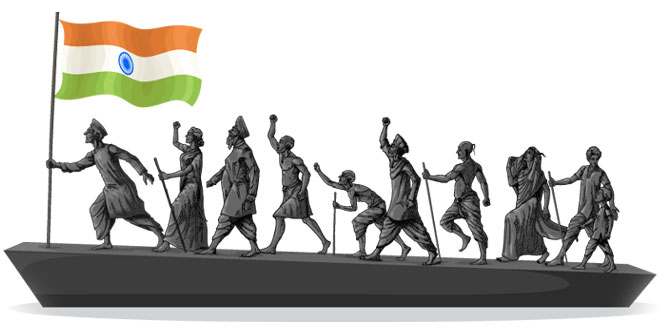Question: Why salt was chosen as a weapon by Gandhiji to fight against the Britishers? Or Why did Mahatma Gandhi perceive ‘salt’ as a powerful symbol that unite the nation?
Answer:
- Salt was something consumed by the rich and the poor alike, and it was one of the most essential items of food.
- The tax on salt and the government monopoly over its production, revealed the most oppressive face of the British rule.
- Salt was chosen to give the movement a wide base.
Question: Why did the poor peasants join the Civil Disobedience Movement? Why did the relationship between the poor peasants and the Congress remain uncertain?
Answer:
- The poor peasants had their own problems. They were not just interested in lowering of the revenue, but also demanded remission of rent which they had failed to pay during the depression years.
- In some parts of the country, they launched a ‘no rent’ campaign which was not supported by the Congress because this might had upset the rich peasants and landlords.
- These poor peasants joined a variety of radical movements, often led by Socialists and Communists. So the relationship between the poor peasants and the Congress remained uncertain.
Question: Why did the business class participate in the Civil Disobedience Movement?
Answer:
- The business class wanted protection against imports of foreign goods.
- They wanted to free the business from colonial restrictions.
- The business community interpreted Swaraj in their own way. They came to see Swaraj at the time when colonial restrictions on business would no longer exist and trade industry would flourish without constraints.
Question: Who led the business community during the Civil Disobedience Movement? How did the community provide a big boost to the movement?
Or
Explain with examples the role of industrialist in the freedom struggle of India.
Or
Explain the attitude of the Indian merchants and the industrialist towards the ‘Civil Disobedience Movement.’
Answer: The business community was led by prominent: industrialists like Mr. Purshottam Das and Mr G.D. Birla.
- By opposing colonial policies: The industrial class was keen on expanding their business, so they reacted against colonial policies that restricted business activities. They I wanted protection against imports of foreign goods, and a rupee-sterling foreign exchange ratio that would discourage imports.
- Forming various organisations: To organize business interests, they formed the Indian Industrial and Commercial Congress in 1920 and the Federation of the Indian Chamber of Commerce and Industries (FICCI) in 1927.
- Support to Civil Disobedience Movement: Led by prominent industrialists like Purshottamdas Thakurdas and G. D. I Birla, the industrialists attacked colonial control over the Indian economy, and supported the Civil Disobedience Movement when it was first launched.
- Financial aid: They gave financial assistance and refused to buy or sell imported goods. Most businessmen came to see Swaraj as a time when colonial restrictions on business would no longer exist and trade and industry would flourish without constraints.
- Role of working class: The industrial working class also participated in the Civil Disobedience Movement. In 1930 thousands of workers in Chotanagpur participated in protest rallies and boycott campaigns.
Question: Why did the business community later on withdraw from the Civil Disobedience Movement?
Answer:
- After the failure of the Round Table Conference, business groups were no longer uniformly enthusiastic.
- They were apprehensive of the spread of militant activities, and worried about prolonged disruption of business.
- They were worried about the growing influence of socialism amongst the younger members of the Congress.
Question: Why the industrial working class did not participate in the Civil Disobedience Movement in large numbers? Mention any two demands of the workers who participated in the movement. Or “The Congress was reluctant to include the demands of industrial workers in its programme of struggle.” Analyse the reasons.
Answer: The industrial working classes did not participate in the Civil Disobedience Movement in large numbers, except in the Nagpur region. This was because industrialists were supporting the Movement and Congress was reluctant to include workers’ demand as part of the Movement. Demands of workers (1) They demanded higher wages. (2) They demanded proper working conditions.
Question: Explain the effects of ‘worldwide economic depression’ on India, towards late 1920s.
Answer:
- The depression immediately affected Indian trade. India’s exports and imports nearly halved between 1928 and 1934. As international prices crashed, prices in India plunged. Between 1928 and 1934, wheat prices in India fell by 50 per cent.
- The fall in prices had a deep impact on the poor farmers. Though agricultural prices fell sharply but the colonial government refused to give any relief to the farmers in taxes. Peasants producing for the world market were the worst hit Their indebtedness increased. They were forced to sell or mortgage their land. People were forced to sell their assets like T gold and silver. Indian jute producers were worst affected.
- The unrest created by the Great Depression provided an opportunity to Mahatma Gandhi to launch the Civil Disobedience Movement in 1931.
- The depression proved less grim for urban India. Because of falling prices those with fixed income-like town-dwelling landowners who received rents and middle-class salaried employees-now found themselves better off. Everything cost less. Industrial investment also grew as the government extended tariff protection to industries, under the pressure of nationalist opinion.
 Class Notes NCERT Solutions for CBSE Students
Class Notes NCERT Solutions for CBSE Students





